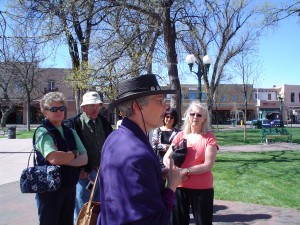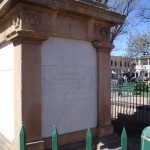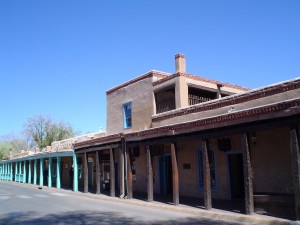Plaza merchants shook their stores from slumber as city workers swept the square, their conversation a melodic Spanish carried by the spring breeze. Huddled in the morning chill, we were walkers from St. Louis, New Jersey, Maine, Florida, New York and Michigan, led by a woman from California who was about to bring aboard a few folks like Napoleon, Willa Cather and a Native American saint.
 “The Italians did not have tomato sauce,” declared Pat Kuhlhoff. “The Swiss did not make chocolate. And there was never a potato famine in Ireland until Christopher Columbus discovered the Americas.”
“The Italians did not have tomato sauce,” declared Pat Kuhlhoff. “The Swiss did not make chocolate. And there was never a potato famine in Ireland until Christopher Columbus discovered the Americas.”
With that, Kuhlhoff began one of the downtown Santa Fe historic walking tours she has conducted on behalf of the Palace of the Governors for 17 years. She and other volunteers rotate responsibility for the tours every Monday-through-Saturday from mid-April through mid-October.
It’s an informal start: Gather at what we museum folks know as “The Blue Gate” – a wooden gate on the east side of Lincoln Avenue that divides the Palace of the Governors from the New Mexico History Museum.
Tours cost $10, last up to two hours (depending on how many questions you ask), don’t require reservations, rarely achieve a pace more strenuous than an amble, and provide a stop for drinking fountains and restrooms. (The museum guides, by the way, do not accept tips.)
Kuhlhoff begins her tour by drawing connections between visitors’ home states and the American Southwest. “All of King George’s Red Coats got their red from Mexico,” she tells an East Coaster. In a way, she’s subverting the standard U.S. educational view of American history, as something that started back East and eventually pioneered its way to a desolate West.
In fact, Kuhlhoff tells her dozen walkers, Santa Fe’s history began some 14,000 years ago with Native peoples who farmed, tamed turkeys and dogs, fought with one another, and then fought with European settlers, before reaching accommodations that led to today’s Southwestern melting pot and its still-distinct ethnic ingredients.
 Standing in the Plaza, Kuhlhoff points to the obelisk commemorating those who died in the so-called Indian wars. She tells of how the word “savage” was chiseled out of its inscription – an oft-told story – but drops in something new: Napoleon saw obelisks used as memorials in Egypt and brought the idea back to France, where it took root and spread.
Standing in the Plaza, Kuhlhoff points to the obelisk commemorating those who died in the so-called Indian wars. She tells of how the word “savage” was chiseled out of its inscription – an oft-told story – but drops in something new: Napoleon saw obelisks used as memorials in Egypt and brought the idea back to France, where it took root and spread.
(We can also thank Napoleon for Southwestern punched-tin decorative arts, Kuhlhoff says. The general decided tin cans were the best way to move goods across long distances. Once goods made it all the way to Santa Fe, throwing away the cans they came in was deemed wasteful, so they were recycled into objects that now typify Santa Fe style.)
Kuhlhoff makes me see, for the first time, the gargoyle heads atop the Catron Block building at Washington and Palace.
She leads us into the Rainbow Man Courtyard on East Palace and points to the office where scientists for the Manhattan Project once learned of their top-secret orders.
 On the corner of Cathedral and Palace, she compares and contrasts Territorial, Pueblo, Mission and Romanesque architectural styles.
On the corner of Cathedral and Palace, she compares and contrasts Territorial, Pueblo, Mission and Romanesque architectural styles.
Near the river, she stops at a bed of native plants and deftly IDs yarrow, poppies, aspens – before noting that, just upstream, nuclear secrets were exchanged, a crime that led to the executions of Julius and Ethel Rosenberg.
On the steps of St. Francis Cathedral, she introduces visitors to the statue of Blessed Kateri Tekakwitha, the first female Native American to attain beatification, and tells a bit of the history of Bishop Lamy, noting drily that Willa Cather’s Death Comes for the Archbishop is “not historically accurate, but popular.”
The walk includes information on the railroad era (with a timely restroom break at La Fonda) and on the use of acequias to move the desert’s most precious natural resource: water.
“You’re with these people such a short time and you don’t get to know them, so I try to make it really broad,” Kuhlhoff said afterward. “If you go into too much detail, people don’t have a basic framework.”
Getting that basic framework to them is easier said than done: “With the docent training we get,” Kuhlhoff said, “I could have these people out there for four days.”

Pingback: Santa Fe tidbits: National Park Week, Ghost Ranch, walking tours and more… | Santa Fe Travelers with Billie Frank & Steve Collins
Pingback: NM History Museum News Blog » Blog Archive » Palace Windows Get Technical Support
Pingback: Santa Fe – New Season of Downtown Walking Tours » Southwest Flair ~ The Online Magazine for Southwest Style ~ Add a Little Southwest Flair to Your Life!
Pingback: Santa Fe – New Season of Downtown Walking Tours - Discover New Mexico » Discover New Mexico
Pingback: Santa Fe – New Season of Downtown Walking Tours - Guidebook America Plus » Guidebook America Plus
Pingback: Santa Fe – New Season of Downtown Walking Tours - Discover New Mexico News » Discover New Mexico News
Pingback: NM History Museum News Blog » Blog Archive » Wanted: History Buffs with Shoes Made for Walkin’